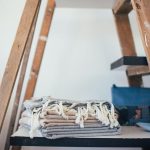So, you've mastered the art of quilt-making, but now you face the daunting decision of choosing the best batting material.
Fear not, for the world of quilt batting is vast and varied. From the classic cotton to the luxurious wool, the options are plentiful. Each material has its own unique qualities, and understanding them will empower you to make the perfect choice for your masterpiece.
Whether you seek breathability, warmth, or durability, there's a batting material that suits your needs. Let's explore the nuances of cotton, wool, polyester, bamboo, and blended battings to unravel the mysteries and find the best one for your quilt.
Key Takeaways
- Cotton batting is a soft and breathable option suitable for all climates and offers excellent stitch definition.
- Wool batting provides superior insulation for cold climates and has moisture-wicking properties, while also maintaining loft and resilience over time.
- Polyester batting is lightweight and hypoallergenic, making it a versatile option for hand and machine quilting, with various thickness options available.
- Bamboo batting is a sustainable choice with excellent airflow for breathability, a silkier texture, and natural antibacterial and antifungal properties.
Cotton Batting
When making a quilt, you should consider using cotton batting for its softness and breathability. Cotton batting benefits quilters by providing a lightweight and breathable layer that's perfect for all climates. Its natural fibers allow for excellent stitch definition, making it ideal for showcasing intricate quilting techniques.
Quilting techniques are enhanced by the use of cotton batting due to its ability to hold up well to washing and wear, giving your quilt that classic crinkly look after it's been laundered. Additionally, cotton batting allows for a greater variety of quilting patterns and densities, giving you the flexibility to create unique and beautiful designs.
Furthermore, cotton batting benefits quilters by being easy to work with, as it can be quilted up to 8 inches apart, allowing for more open and creative quilting designs. Its soft and gentle drape makes it perfect for both hand and machine quilting, giving your finished quilt a lovely, supple feel.
When considering the best batting material for your quilt, cotton batting should be a top choice for its numerous benefits and compatibility with various quilting techniques.
Wool Batting
If you're looking for a warm and insulating option for your quilt, wool batting is an excellent choice to consider after discussing the benefits of cotton batting. Wool batting offers several advantages that make it a desirable option for quilters seeking warmth, durability, and natural materials.
Here are some key benefits of wool batting:
- Superior Insulation: Wool is known for its exceptional insulating properties, making it an ideal choice for quilts intended for cold climates or winter use.
- Moisture Wicking: Wool has the ability to wick away moisture, keeping you dry and comfortable while you sleep. This feature is particularly beneficial for individuals who may experience night sweats or hot flashes.
- Resilience and Loft: Wool batting maintains its loft and resilience over time, ensuring that your quilt retains its fluffy and plush appearance even after repeated use and washing.
- Sustainable and Eco-Friendly: Wool is a renewable and biodegradable material, making it an environmentally conscious choice for quilters who prioritize sustainability.
When caring for wool batting, it's important to follow specific guidelines to maintain its integrity. Avoid excessive agitation when washing, use a gentle detergent, and air dry or tumble dry on a low heat setting to preserve the loft and texture of the wool.
Polyester Batting
Polyester batting offers a lightweight and hypoallergenic alternative to wool batting for your quilt. When it comes to quilting techniques, polyester batting is a versatile option. Its ability to maintain its shape and thickness makes it suitable for both hand and machine quilting. The flexibility of polyester batting allows you to create intricate quilting designs with ease, making it a popular choice among quilters.
Batting thickness is an important consideration when selecting the right material for your quilt. Polyester batting comes in various thickness options, ranging from thin to thick. The thin polyester batting is ideal for achieving a flatter appearance in your quilt, while the thicker options provide extra loft and warmth. Understanding the desired outcome of your quilting project will help you determine the most suitable thickness for your polyester batting.
Bamboo Batting
Bamboo batting offers an eco-friendly and breathable alternative to polyester batting for your quilt, giving you a sustainable and airy option to consider. When comparing bamboo batting with cotton, you'll find that bamboo has a silkier texture and better drape, making it an excellent choice for quilts with a luxurious feel.
Here are some key benefits of bamboo batting to help you make an informed decision:
- Sustainability: Bamboo is a renewable resource that grows quickly and requires minimal water and no pesticides, making it an environmentally friendly choice for batting material.
- Breathability: Bamboo batting allows for excellent airflow, keeping you cool in the summer and warm in the winter, providing a comfortable sleeping experience.
- Softness: Bamboo batting is incredibly soft to the touch, offering a smooth and luxurious feel, perfect for creating a cozy quilt.
- Antibacterial properties: Bamboo contains natural antibacterial and antifungal properties, making it a great choice for those with sensitive skin or allergies.
Blended Batting
Blended batting offers a versatile option for quilters seeking a combination of different fibers for their quilt projects. By blending different materials, quilt batting can achieve a balance of qualities that may not be present in a single type of fiber. This can result in improved warmth, drape, and stitch definition in your quilts. The blending process involves carefully combining various fibers to create a batting that possesses the desired characteristics. Here are some benefits of using blended batting:
| Blended Batting Benefits | Description |
|---|---|
| Enhanced Warmth | Blending materials can result in a batting that provides enhanced warmth without adding excessive weight to the quilt. |
| Improved Durability | The combination of different fibers can lead to increased durability, ensuring that your quilt will maintain its quality over time. |
| Varied Texture | Blended batting can offer a unique texture, adding depth and interest to your quilting projects. |
Blended batting provides an opportunity to customize the qualities of the batting to suit the specific needs of your quilt. Understanding the blending process can empower you to make informed decisions when selecting batting for your quilting projects.
Frequently Asked Questions
What Are the Environmental Impacts of Each Type of Batting Material?
Consider the environmental impact and sustainability of each batting material. Look into the production process and energy usage associated with them. This will help you make an informed decision that aligns with your values.
Are There Any Special Care Instructions for Quilts Made With Each Type of Batting?
To ensure your quilt's longevity and durability, follow specific care instructions for each type of batting. Regularly fluff and air out your quilt to maintain its quality and freshness. Proper maintenance guarantees a cozy and enduring quilt.
How Does Each Type of Batting Material Affect the Drape and Feel of the Finished Quilt?
When choosing batting material for your quilt, consider how each type affects the drape and comfort feel. Some options offer a variety of color choices and cost efficiency. Keep these factors in mind for a quilt that meets your needs.
Are There Any Specific Types of Quilting Projects That Are Better Suited for Each Type of Batting Material?
Consider the specific types of quilting projects when choosing batting. For heavier, warmth-focused quilts, wool or polyester may be suitable. Cotton or bamboo are better for lighter, more breathable quilts. Consider environmental impact and material sourcing.
Are There Any Potential Allergens or Sensitivities Associated With Using Each Type of Batting Material?
When choosing batting material for your quilt, it's essential to consider potential health risks and allergen awareness. Be aware of sensitivity concerns and material considerations, as certain types of batting may trigger allergies or skin irritations.
- Is Chiffon Wrinkle Resistant? - April 23, 2024
- Is Chiffon Hot to Wear? - April 23, 2024
- Is Chiffon Shiny? - April 23, 2024







